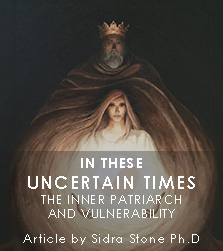by Hal Stone, Ph.D. & Sidra Stone, Ph.D.
continued from
with
both of them and will continue to do so until she is able to separate from her Pleasing Daughter
and learn to embrace it and the Selfish Self, on
the other side, without being identified with
either one.
George is a successful trial lawyer. He has the reputation of being tough but fair. He hates “wimps.” A “wimp” is someone who is weak and vulnerable and who cannot take care of himself or herself. A wimp cries a lot and always seems to be victimized by the world. Unfortunately, George’s daughter fulfills all of these requirements. George is very hooked into her because she suffers terribly at school and with her friends. Everyone seems to take advantage of her. In his growing years George had parents who were very strict with him, especially his father. George’s Protector/ Controller pulled in a strong group of selves to make up a powerful operating ego. These included a Pusher, a Money Maker, an Ambitious self, a Perfectionist, a Controlling Father self, and a very strong Power Broker. Vulnerability, weakness of any kind, shyness, all became an anathema to these primary selves. However, every disowned self returns to haunt us in our life over and over again. We marry them, our children live them out, they become our business partners, or our enemies. George’s daughter lives out all of his disowned material. Until George is able to separate his aware ego from his primary selves, he will never be able to learn to honor the selves on the other side and, perhaps in that process, free his daughter from her role as the family victim.
These disowned selves present each of us with an unparalleled opportunity to learn and to grow. We must, however, stand back from the people in our lives that cause us pain and stress and recognize them as teachers that are essential for our own personal development. The greater the hatred and judgment, the more powerful is the disowned self operating within us.
Jane hates powerful, dominating women. She sees herself as being more loving and compassionate. Her system of primary selves developed as a reaction formation against a forceful and dominating mother. Now she hates aggressive, dominating women. We may be sure that life will bring her a series of aggressive dominating women for her to fight with and suffer over until she learns the lessons of disowned selves. Her best friend is such a person. Jane says, ‘I can’t understand why I’m friends with her. We’re so opposite. Most of the time I don’t know if I’m loving her or hating her!’
Embracing and honoring a disowned self does not mean that one needs to become that self. It simply means that one must disengage from the primary self system and learn to honor the selves on the other side. It is not necessary to try to change one’s behavior or to become somebody different. One need simply say something like, ‘Look I recognize you. You terrify me and I cannot let you take over my life, but I do know that you are there and I will be aware of you and I will listen to your words. I will feel your feelings and I will honor you as best I can.’ When disowned selves first come out, they are often absolute terrors. Once they are out, however, we find that what they want is to be acknowledged, to be honored, to be listened to and taken seriously, just in the same way that you and I need to be taken seriously.
This, of course, is the crux of the matter. These selves, as we have said from the beginning, are real people. They inhabit our bodies, but they are real people. When they are ignored, they get nasty and they become vindictive towards us. The longer and deeper that they are imprisoned, the crazier they tend to become so when they finally emerge it is often in a very primitive form, ‘proving’ for the primary selves that they were properly disowned in the first place!
If one has been forced to disown natural instinctual energies as most of us have, these energies build up power in the unconscious and become frightening, perhaps even destructive. In this disowned state, they may develop unnatural power over us. They become our hated enemies. In their extreme forms, we sometimes refer to them as ‘daemonic.’ A Protestant minister has disowned his sexuality over many years. In the course of his therapy, he dreams that he is trying to wrestle a drunk penis into the cold shower. His sexuality was not drunk to begin with. It was just sexuality. Disowned over time, the sexuality acquired greater and greater energy and became more difficult to control. In a few years, if nothing were to change, we can probably assume that it would no longer be manageable and then there might well be a more serious consequence of this disowning process. We recently have seen this process lived out by a number of television evangelists whose disowned selves exploded into public prominence and caused no end of discomfort for everyone.
Does this mean that our minister has to live out his sexuality in the world? Not necessarily so. It means that he has in him feelings and a voice that wishes to express those feelings. He must separate the aware ego from the Protector/ Controller and its friends and begin to embrace both sides. He has to learn to live with his Monk and with Dionysius. He must learn to honor both selves and what they represent. What he will actually do to honor these energies is his to decide. Hopefully, he will have an aware ego making his decision for him.
Honoring the selves does not mean letting them take over one’s life. If someone is very constricted and suddenly discovers the freer, more flowing selves, our job as therapists is not to support the new flowing selves against the constriction of the more traditional selves. All this would do is substitute one extreme for the other. This is an extremely critical issue in new age consciousness. Our experience is that the more conservative and constricted side of our nature has become a disowned self for most people involved in consciousness work. In the attempt to grow and change, one’s back gets turned on our origins, our basic conservatism. This disowned conservatism is then projected back onto the society that is seen quite judgmentally as being constricted and negative. Though the perception may have some accuracy, the judgment behind it does not help things in any way.
None of us can be saved from the reality of our disowned selves. There is nothing pathological in this situation. Each of us at this moment is identified with a primary self system and each of us has a disowned or lessowned self system that is operating. No amount of psychological work can save us from this condition. The unconscious is unconscious! Wisdom is, at least in part, the knowledge of this reality. And what a relief we can experience if we truly accept this!
The Psychology of Selves
The Psychology of Selves is basically a way of
viewing the evolution of consciousness in an
individual. Consciousness is not a goal to be
reached by a process that is embraced. There
are three distinct aspects of the consciousness
process. These are: awareness; experience of
selves; and the aware ego.
1. Awareness is a point of reference that allows one to view with objectivity whatever is happening inside or outside of ourselves. There is no judgment and there is no attachment as to how one should be in the world. There is just the act of witnessing what actually is in one’s world. Awareness is simply a point of reference, a place of pure insight. It is not an action state.
2. The second level of our distinction concerns the actual experience of different selves of energy patterns. The experience of anger is different from the awareness of anger. If one experiences anger and has no awareness of it, then one remains locked into this affective state and consciousness cannot evolve. If one has an awareness of anger with no experience of it, then one remains locked at an awareness level and consciousness cannot proceed. This is the reason why so many strong meditators that we see in clinical practice often have no relationship to their passions. They define consciousness as awareness and reject that act of experiencing the emotions. By the same token, individuals who have worked with a therapist or teacher who identify expression of emotions as the fundamental transformational path, may remain locked into the emotional plane, forever reacting emotionally with no ability to disengage anytime from the emotions. Both are necessary— awareness and experience.
3. The third component of consciousness is the process of the aware ego. Historically speaking, the ego has always been defined as the executive function of the psyche, the choice maker. This definition is as good today as it was at the beginning of the century. We have already differentiated between the operating ego and the aware ego. The aware ego, as we have seen, grows little by little as it is able to separate from the primary selves and learns to embrace the opposing disowned or less developed system of selves.
The aware ego, unlike awareness, is an action state. The action may be directed towards the world or it may simply be the ability to hold and live with the tension of opposites.
The Path Ahead
The exploration and mapping of the psyche—
particularly its darker and more frightening
corners—brings amazing new insight and
excitement to our lives. Knowing the terrain
within us lessens our fear and vulnerability and
enables us to see both the opportunities and
the dangers in life more clearly. Integrating
new selves brings much added richness to our
experiences. Replacing an operating ego with an
aware ego gives a surprising number of choices
in life where before there was none.
All therapy and growth forms are working at some level with these different selves. Voice Dialogue is a method we have evolved that has served us particularly well.
There is no end to the selves that can be contacted by this method. If they feel treated with respect and honor, and that the facilitator is treating them as real people, these voice systems open up in the most remarkable ways. This technique, which can be used by a wide variety of individuals, both professional therapists and layman alike, is described in detail in our book, Embracing Our Selves: The Voice Dialogue Manual.
The discovery of the multiple selves that
inhabit the psyche and run our lives without
our knowledge is the number one task of
consciousness. It is only by truly assuming
responsibility for ourselves that we can stop
seeing them in other people. After all, those
many people out there that we judge and
hate and overvalue are direct expression of
our disowned inner nature. By claiming all
of our heritage, we naturally must view our
fellow humans with greater compassion
and understanding and accept our share of
responsibility for both the difficulties and the
well-being of the planet.
©1994






